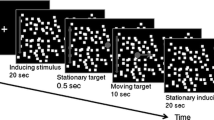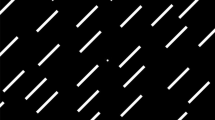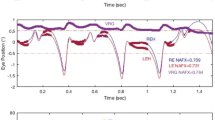Summary
Rabbits were placed inside a striped drum, which was rotated at selected constant speeds around the animal's sagittal or bitemporal axis. Eye position was recorded by means of the scleral search coil system. A regular vertical or rotatory optokinetic nystagmus (OKN) was constantly obtained. The ratioslow phase eye velocity/drum velocity (=gain) amounted to 0.7–0.9 for stimulus velocities up to 1°/sec, and declined progressively for higher stimulus velocities. The overall input-output relations for torsional and vertical OKN were very similar to those found previously for horizontal OKN. Upward and downward motion were equally effective as a stimulus for each eye apart. The same was true for nasal and temporal rotation.
In darkness, rotatory and vertical drift of the eye was seen, as described before for the horizontal plane. These findings support the hypothesis that the OKN system stabilizes the eyes on the (non-rotating) visual surroundings.
It is proposed that vertical, torsional as well as horizontal OKN are mediated by sub-sets of similar retinal direction-selective cells as described in the literature.
Similar content being viewed by others
References
Brecher, G. A.: Die optokinetische Auslösung von Augenrollung und rotatorischen Nystagmus. Pflügers Arch. ges. Physiol.234, 13–28 (1934).
—: Optisch ausgelöste Augen- und Körperreflexe am Kaninchen. Z. vergl. Physiol.23, 374–390 (1936).
Collewijn, H.: Optokinetic eye movements in the rabbit: input-output relations. Vision Res.9, 117–132 (1969).
—: The normal range of horizontal eye movements in the rabbit. Exp. Neurol.28, 132–143 (1970).
—: An analog model of the rabbit's optokinetic system. Brain Res.36, 71–88 (1972).
— Van der Mark, F.: Ocular stability in variable visual feedback conditions in the rabbit. Brain Res.36, 47–57 (1972).
Magnus, R.: Körperstellung. Berlin: Springer 1924.
Oyster, C. W.: The analysis of image motion by the rabbit retina. J. Physiol. (Lond.)199 613–635 (1968).
— Barlow, H. B.: Direction-selective units in rabbit retina: distribution of preferred directions. Science155, 841–842 (1967).
— Takahashi, E., Collewijn, H.: Direction-selective retinal ganglion cells and control of optokinetic nystagmus in the rabbit. Vision Res.12, 183–193 (1972).
Prince, J. H.: The rabbit in eye research. Springfield, Ill.: Ch. C. Thomas 1964.
Robinson, D. A.: A method of measuring eye movement using a scleral search coil in a magnetic field. IEEE Trans. Biomed. Electron.10, 137–145 (1963).
—: Models of oculomotor organization. In: The control of eye movements (Ed. P. Bach.y-Rita, and C. C. Collins) New York: Academic Press 1971.
Van der Hoeve, J., De Klein, A.: Tonische Labyrinthreflexe auf die Augen. Pflügers Arch. ges. Physiol.169, 241–261 (1917).
Author information
Authors and Affiliations
Rights and permissions
About this article
Cite this article
Collewijn, H., Noorduin, H. Vertical and torsional optokinetic eye movements in the rabbit. Pflugers Arch. 332, 87–95 (1972). https://doi.org/10.1007/BF00589086
Received:
Issue Date:
DOI: https://doi.org/10.1007/BF00589086




